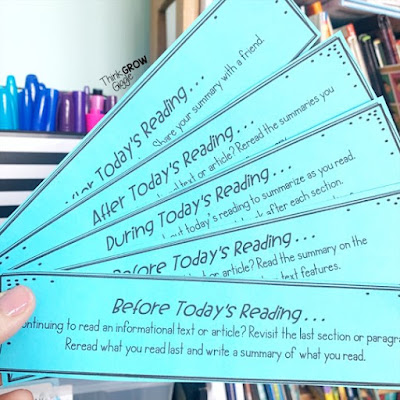Before jumping into summarizing nonfiction there are a few lessons that I teach prior to writing nonfiction summaries. Read on to see how I teach nonfiction summarizing in my classroom, breaking it down into different lessons that help students understand how to summarize informational text.
1. Distinguish Interesting VS. Important
My students always benefit from lessons on distinguishing the difference between interesting and important information. This is critical when they are writing nonfiction summaries.
Begin by simply discussing the difference between what makes something interesting in the books that they read and what makes something important.
Here is how I explain the difference:
Interesting: Something new that I did not know that piqued my curiosity.
Important: Something that I read that supports the main idea of the reading.
I go one step further to call students' attention to the N in interesting. That helps us remember that interesting is usually something New to us. Looking at the word important, I call attention to the M. That reminds us that it supports the Main idea. This simple trick makes a huge impact on students' understanding of interesting and important.
A great book to use for a lesson on determining importance is Henry’s
Freedom Box by Ellen Levine. As we read,
we chart information into an Interesting vs Important Tchart. This book and activity helps students distinguish the difference, and improve their summary
writing as they focus on only the important information.
TSMIDS simply stands for topic sentence, main idea, and details that support.
I use this frame to show students how to write a quick
summary. This is a good format to use when students are discussing sections of
a nonfiction book or article. This is also perfect for students to summarize what is going on within their book when you meet with them for reader’s workshop group time and conferencing. Once students master this format, I expect them to add more to their summaries.
3. Model Summary Writing with Mentor Texts
When introducing summaries, I like to use informational books or articles that we previously read. I model summary writing with a book that we have already read in class or even informational magazines like Time for Kids. Since we read the Moon Book during our science unit it is a great one for us to revisit as readers who are writing summaries.
Teacher tip: Be sure to grab the free resources above to grab the modeled example for a nonfiction summary using the Moon Book.
Once I have modeled my expectations, we write a few nonfiction summaries together, again using books that we have already read as a class. I like to use books and articles that we have already read because I know students already understand the main idea in the books that we have read and discussed as a class. This allows them to focus on writing a summary with important information, rather than reading the book for understanding.
Informational texts and authors that I like to use
that have been previously read include:
- Time For Kids magazine (also online articles from TFK)
- Anything written by Gail Gibbons or Seymour Simon
- National Geographic Book Series
- Rookie Readers
- I Can Read (highest level readers)
- Let’s Read and Find Out Series





















